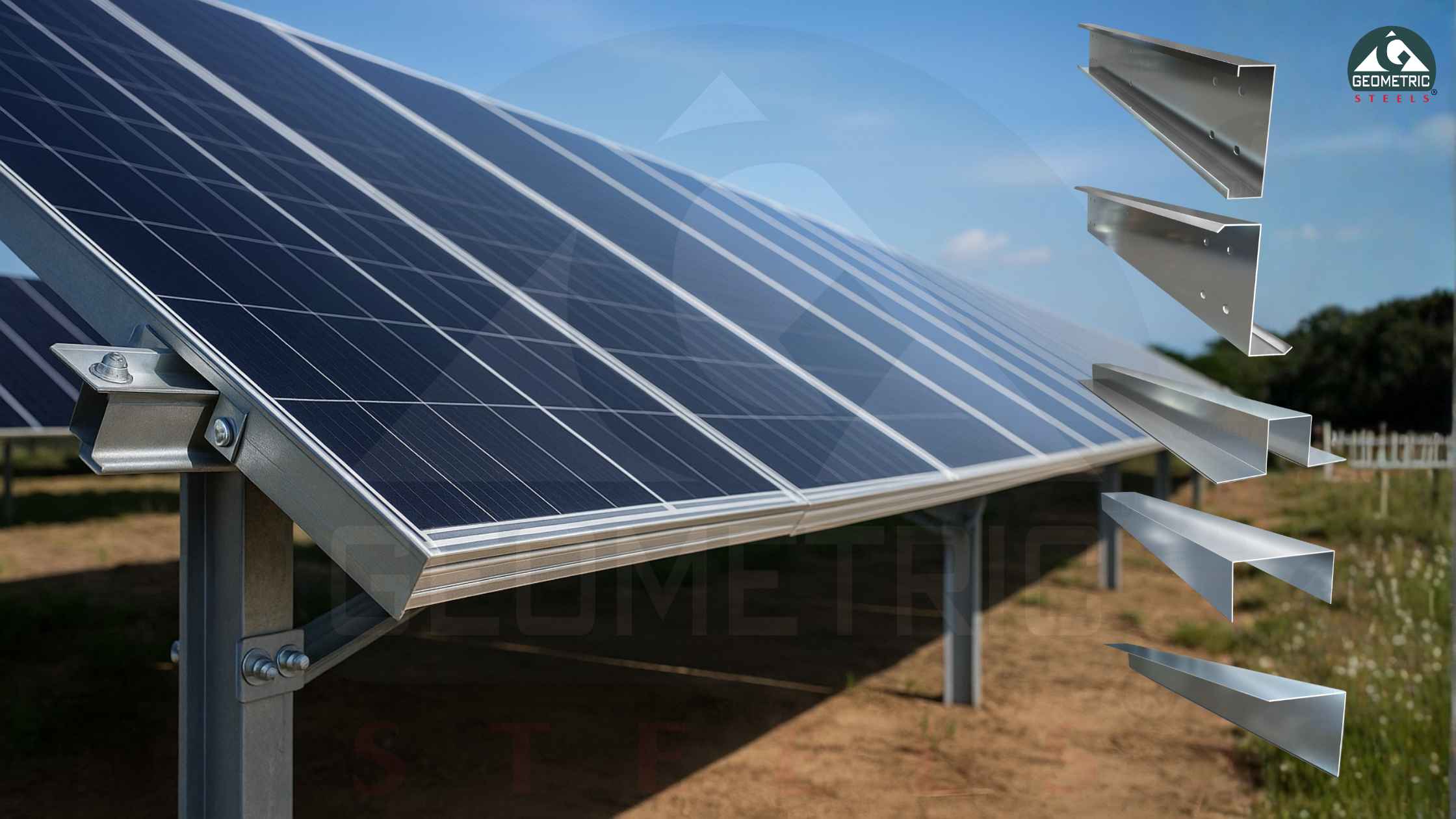
With the rise of renewable energy, solar installations are becoming integral to industrial, commercial, and even residential infrastructure. Yet, behind every efficient solar system lies a silent performer — the purlin. These structural members form the backbone of solar panel mounting systems, ensuring stability, strength, and long-term alignment of modules.
Optimizing purlins can improve energy output by up to 32%, reduce installation time, and lower structural costs. Whether it’s a ground-mounted solar farm or a rooftop installation, choosing the right purlin type — C, Z, Hat, or U — can significantly enhance system performance and durability.
Purlins are horizontal beams that run along the length of a structure, providing direct support to solar panels and evenly distributing the load to the rafters or primary frame. In solar mounting systems, they serve a dual purpose: maintaining the structural integrity of the module layout and minimizing deflection under environmental stress such as wind or snow loads.
Most solar structures utilize cold roll-formed galvanized steel (GI, CR, or HR) purlins due to their corrosion resistance and high yield strength — typically between 240 MPa and 350 MPa. These materials provide longevity, crucial for solar systems expected to perform efficiently for over 25 years.
C-Purlins – The Backbone of Rooftop Solar Systems
C-purlins are among the most common profiles used in rooftop solar applications. Their shape provides exceptional strength and rigidity for short- to medium-span structures. They’re particularly suitable for metal roofs or industrial sheds where solar panels are mounted parallel or at a tilt.
The uniform shape of C-purlins allows for easy integration with solar module rails, ensuring alignment precision and reducing labor during installation. Available in thicknesses ranging from 1.2 mm to 3 mm and lengths up to 6 meters, these sections offer reliable support while minimizing material wastage.
Z-Purlins – Optimized for Long Spans and Ground Mounts
When it comes to large-scale solar farms or long-span roof structures, Z-purlins are preferred for their ability to overlap and form continuous lengths. This reduces the need for additional joints and supports, cutting material consumption by up to 50% compared to traditional hot-rolled sections.
Z-purlins also distribute load more evenly and enhance overall rigidity, making them ideal for structures exposed to high wind zones. Their overlapping design simplifies alignment and ensures a cleaner, more aerodynamic layout for solar modules.
Hat Purlins – For Aerodynamic Stability and Load Distribution
Hat purlins, recognized by their high crown and wide flange, are designed to distribute loads uniformly while improving the aerodynamic stability of solar panel arrays. They are ideal for tilt-mounted and tracking solar systems, where consistent weight balance is critical.
Manufactured using AZ150 or G550-grade steel, hat purlins resist deformation and vibration, extending system lifespan. They also facilitate better heat dissipation and airflow beneath panels, indirectly improving energy efficiency.
U-Sections – Lightweight and Versatile Support Members
U-sections are commonly used for lightweight solar structures, carports, and agricultural sheds integrated with solar roofs. Their open, simple geometry offers easy assembly and compatibility with other framing members. Cold roll-forming technology ensures dimensional accuracy while reducing energy consumption during production — aligning perfectly with the sustainability goals of solar infrastructure.
1. Spacing & Alignment
The spacing between purlins depends on the panel size, wind load, and roof type. Proper alignment ensures even weight distribution, reducing the risk of stress concentration and deflection. An optimized spacing layout can cut overall steel consumption by 10–12% while maintaining safety factors.
2. Material & Coating Selection
Material quality plays a direct role in system durability. Galvanized and cold-rolled purlins with 80–275 GSM coating provide long-term corrosion resistance in humid or coastal environments. Higher yield strength grades (up to 350 MPa) help reduce thickness requirements, lowering weight without compromising stability.
3. Structural Design & Bracing
Adding bracing elements between purlins enhances load-bearing capacity and reduces bending moments. Properly braced designs can save up to 15% in structural costs by minimizing the number of support posts and joints required.
4. Minimizing Shading for Bifacial Panels
With the growing use of bifacial solar panels, shading has become a crucial design factor. Poorly placed purlins can reduce rear-surface light reflection, decreasing energy gain by 8–10%. Optimal tilt and purlin positioning can improve energy capture by up to 32%, making design precision essential.
5. Installation Efficiency
Pre-punched holes and pre-galvanized finishes simplify installation and alignment on-site. Such purlins eliminate the need for manual drilling or cutting, reducing labor time and improving assembly accuracy. They are compatible with both riveted and screw-fastened solar rails.
• Higher Energy Efficiency: Better load distribution and tilt stability lead to improved module performance.
• Reduced Material & Labor Cost: Cold roll-formed purlins minimize steel usage while improving installation speed.
• Durability: Galvanized coatings ensure corrosion resistance for 25+ years.
• Safety & Reliability: Engineered designs resist high wind uplift and dynamic loads.
• Sustainability: Recyclable steel and energy-efficient forming align with green building goals.
As the solar industry grows, so does the need for smarter, lighter, and more efficient support systems. The future of purlin optimization will integrate AI-based structural modeling, finite element analysis (FEA), and high-tensile cold-formed steels to create more resilient, eco-friendly systems. Automated roll-forming with precision punching ensures minimal waste and faster installation — a direction already embraced by advanced manufacturers.
At Geometric Steels, our advanced roll-forming technology and high-tensile materials ensure that every C, Z, Hat, and U purlin meets the demands of modern solar panel mounting structures. Engineered for strength, accuracy, and long-term durability, our purlins form the reliable backbone of solar installations across industrial, commercial, and renewable sectors.
📞 +91 8550995556
📧 roof@geometricsteels.com
🌐 www.purlinsection.com
Keywords: purlin for solar panel mounting structure, C purlin for solar panels, Z purlin for solar farms, hat purlin for solar systems, U section solar purlin, galvanized purlin, cold roll formed purlins, solar mounting structure purlins, purlin manufacturer India, Geometric Steels purlin, solar structure design, steel purlin optimization